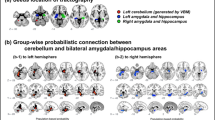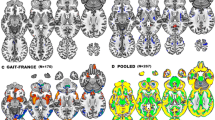Abstract
Gait disturbance and cognitive changes are common with ageing. The cerebellum contributes to motor coordination and participates in various aspects of cognition. However, no research has investigated the possible cerebellar contribution to gait and cognition in non-demented very old individuals. The current study aimed to determine the associations between indices of cerebellar size (vermal area and total volume) and measures of motor and cognitive integrity, as well as the role of variables known to impact on cerebellar size (alcohol consumption and chronological age) in a sample of 111 community dwellers (mean age: 85 years; range: 81–97 years). A marginally significant association was present between age and total vermal area. Significant correlations between current daily alcohol intake and some vermal areas were observed. These associations were more pronounced in men, particularly after controlling for cerebrum size. Multiple linear regression models revealed limited unique contributions of cerebellar predictors to neurological and cognitive measures. In summary, the results indicate that the cerebellum may be susceptible to alcohol-related shrinkage in non-demented very old individuals, more so in men, even at low dose. It also appears that the observed changes in cerebellum size in this population contribute little to neurological and cognitive changes.

Similar content being viewed by others
References
ANALYZE PC AVW 3.0 Biomedical Imaging Resource. Mayo Foundation, Rochester, MN
Appollonio IM, Grafman J, Schwartz V, Massaquoi S, Hallett M (1993) Memory in patients with cerebellar degeneration. Neurology 43:1536–1544
Arroyo-Anllo EM, Botez-Marquard T (1998) Neurobehavioral dimensions of olivopontocerebellar atrophy. J Clin Exp Neuropsychol 20:52–59
Baker KG, Harding AJ, Halliday GM, Kril JJ, Harper CG (1999) Neuronal loss in functional zones of the cerebellum of chronic alcoholics with and without Wernicke’s encephalopathy. Neuroscience 91:429–438
Bekkelund SI, Pierre-Jerome C, Winther J, Mellgren SI (1999) Relationship between brain structure sizes and performing rapid limb movements. A quantitative magnetic resonance study. Eur Neurol 42:185–189
Benton AL, Hamsher K, Varney NR, Spreen O (1983) Contributions to neuropsychological assessment. Oxford University Press, New York
Benton AL, Hamsher K (1983) Multilingual aphasia examination. AJA Associates, Iowa City
Botez-Marquard T, Botez MI (1997) Olivopontocerebellar atrophy and Friedreich’s ataxia: neuropsychological consequences of bilateral versus unilateral cerebellar lesions. Int Rev Neurobiol 41:387–410
Broe GA, Jorm AF, Creasey H, Grayson D, Edelbrock D, Waite LM, Bennett H, Cullen JS, Casey B (1998) Impact of chronic systemic and neurological disorders on disability, depression and life satisfaction. Int J Geriatr Psychiatry 13:667–673
Chung SC, Lee BY, Tack GR, Lee SY, Eom JS, Sohn JH (2005) Effects of age, gender, and weight on the cerebellar volume of Korean people. Brain Res 1042:233–235
Daum I, Ackermann H, Schugens MM, Reimold C, Dichgans J, Birbaumer N (1993) The cerebellum and cognitive functions in humans. Behav Neurosci 107:411–419
Double K, Halliday GM, Kril JJ, Harasty J, Cullen K, Brooks W, Creasey H, Broe G (1996) Topography of brain atrophy during normal aging. Neurobiol Aging 17:513–521
Escalona PR, McDonald WM, Doraiswamy PM, Boyko OB, Husain MM, Figiel GS, Laskowitz D, Ellinwood EH, Krishnan KR (1991) In vivo stereological assessment of human cerebellar volume: effects on gender and age. Am J Neuroradiol 12:927–929
Esiri MM, Hyman BT, Beyreuther K, Masters CL (1997) Ageing and dementia. In: Graham D, Lantos PL (eds) Greenfield’s neuropathology. Arnold, London, pp 153–233
Fiez JA, Raife EA, Balota DA, Schwarz JP, Raichle ME, Petersen SE (1996) A positron emission tomography study of the short-term maintenance of verbal information. J Neurosci 16:808–822
Grafman J, Litvan I, Massaquoi S, Stewart M, Sirigu A, Hallet M (1992) Cognitive planning deficit in patients with cerebellar atrophy. Neurology 42:1493–1496
Hanes KR (1997) New Tower of London, 2nd ed. Vanguard, Carlton
Harper CG, Kril JJ (1990) Neuropathology of alcoholism. Alcohol Alcohol 25:207–216
Hommer DW, Momenan R, Kaiser E, Rawlings RR (2001) Evidence for a gender-related effect of alcoholism on brain volumes. Am J Psychiatry 158:198–204
Jernigan TL, Archibald SL, Fennema-Notestine C, Gamst AC, Stout JC, Bonner J, Hesselink JR (2001) Effects of age on tissues and regions of the cerebrum and cerebellum. Neurobiol Aging 22:581–594
Johnson-Greene D, Adams KM, Gilman S, Kluin KJ, Junck L, Martorello S, Heumann M (1997) Impaired upper limb coordination in alcoholic cerebellar degeneration. Arch Neurol 54:436–439
Kaplan EF, Goodglass J, Weintraub S (1983) The Boston naming test, 2nd ed. Lea & Febiger, Philadelphia
Karhunen PJ, Erkinjuntti T, Laippala P (1994) Moderate alcohol consumption and loss of cerebellar Purkinje cells. Brit Med J 308:1663–1667
Kaye K, Grigsby J, Robbins LJ, Korzun B (1990) Prediction of independent functioning and behavior problems in geriatric patients. J Am Geriatr Soc 38:1304–1310
Kril JJ, Halliday GM (1996) Brain shrinkage in alcoholics: a decade on and what have we learned? Prog Neurobiol 58:381–387
Luft AR, Skalej M, Welte D, Voigt K, Klockgether T (1997) Age and sex do not affect cerebellar volume in humans. Am J Neuroradiol 18:593–596
Mann K, Gunther A, Schroth G (1992) Do women develop alcoholic brain damage more readily than men? Alcohol Clin Exp Res 16:1052–1056
Miller EN (1996) CalCAP California computerized assessment package manual. Norland Software, Los Angeles
National Health and Medical Research Council (2001) Australian alcohol guidelines: Health risks and benefits. Commonwealth of Australia, Canberra. Available online: http://www.nhmrc. gov.au
Odenheimer G, Funkenstein HH, Beckett L, Chown M, Pilgrim D, Evans D, Albert M (1994) Comparison of neurologic changes in “successfully aging” persons vs the total aging population. Arch Neurol 51:573–580
Orgogozo JM, Dartigues JF, Lafont S, Letenneur L, Commenges D, Salamon R, Renaud S, Breteler MB (1997) Wine consumption and dementia in the elderly: a prospective community study in the Bordeaux area. Rev Neurol 153:185–192
Paradiso S, Andreasen NC, O’Leary DS, Arndt S, Robinson RG (1997) Cerebellar size and cognition: correlations with IQ, verbal memory and motor dexterity. Neuropsych Neuropsychol Behav Neurol 10:1–8
Paulesu E, Frith CD, Frackowiak RS (1993) The neural correlates of the verbal component of working memory. Nature 362:342–345
Petersen SE, Fox PT, Posner MI, Mintun M, Raichle ME (1988) Positron emission tomographic studies of the cortical anatomy of single word processing. Nature 362:585–589
Phillips SC, Harper CG, Kril JJ (1987) A qualitative histological study of the cerebellar vermis in alcoholic patients. Brain 110:301–314
Phillips S, Harper C, Kril J (1990) The contribution of Wernicke’s encephalopathy to alcohol-related cerebellar damage. Drug Alcohol Rev 9:53–60
Raz N, Rodrigue KM, Kennedy KM, Dahle C, Head D, Acker JD (2003) Differential age-related changes in the regional metencephalic volumes in humans: a 5-year follow-up. Neurosci Lett 349:163–166
Rhyu IJ, Cho TH, Lee NJ, Uhm C, Kim H, Suh Y (1999) Magnetic resonance image-based cerebellar volumetry in healthy Korean adults. Neurosci Lett 270:149–152
Ruitenberg A, van Swieten JC, Witteman JC, Mehta KM, van Duijn CM, Hofman A, Breteler MMB (2002) Alcohol consumption and risk of dementia: the Rotterdam Study. Lancet 359:281–286
Spreen O, Strauss E (1991) A compendium of neuropsychological tests. Oxford University Press, New York
Waite LM, Broe GA, Creasey H, Grayson DA, Cullen JS, O’Toole B, Edelbrock D, Dobson M (1997) Neurodegenerative and other chronic disorders among people aged 75 years and over in the community. Med J Austr 167:429–432
Waite LM, Broe GA, Grayson DA, Creasey H (2001) Preclinical syndromes predict dementia: the Sydney Older Persons Study. J Neurol Neurosurg Psychiatry 71:296–302
Waite LM, Creasey H, Grayson DA, Edelbrock D, Cullen JS, Brooks WS, Casey BJ, Bennett HP, Broe GA (2001) Clinical diagnosis and disability among community dwellers aged 75 and over: The Sydney Older Persons Study. Australas J Ageing 20:67–72
Wechsler D (1987) Wechsler memory scale—revised. Psychological Corporation, New York
Woodruff-Pak DS, Goldenberg G, Downey-Lamb MM, Boyko OB, Lemieux SK (2000) Cerebellar volume in humans related to magnitude of classical conditioning. Neuroreport 11:609–615
Acknowledgments
This research was supported in part by grants from the National Health and Medical Research Council of Australia (NHMRC), an Infrastructure Stream C grant from the Department of Health of New South Wales, Australia and by the Ageing and Alzheimer’s Research Foundation. We would like to thank Jessica Carroll, Jo Millar and Enid Sawley for data collection. OP is supported by an NHMRC Neil Hamilton Fairley Postdoctoral Fellowship (ID: 222909).
Author information
Authors and Affiliations
Corresponding author
Rights and permissions
About this article
Cite this article
Piguet, O., Cramsie, J., Bennett, H.P. et al. Contributions of age and alcohol consumption to cerebellar integrity, gait and cognition in non-demented very old individuals. Eur Arch Psychiatry Clin Neurosci 256, 504–511 (2006). https://doi.org/10.1007/s00406-006-0671-5
Received:
Accepted:
Published:
Issue Date:
DOI: https://doi.org/10.1007/s00406-006-0671-5




